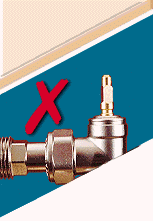Welcome to
CES - Hold-Fast Radiator Valves Limited
Sole UK manufacturers of replacement Tamper-Proof Safety Tops for all radiator valves...





A short history of Hold-Fast Radiator Valves Ltd by Margaret M. Ford
A Council Engineer is strolling down a school corridor with John Ford, a Heating Engineer, when he pauses at a radiator and points to an exposed spindle on a radiator valve. He says: “When, oh when, is somebody going to do something about this problem?” Although the sight of missing tops on radiator valves is very common, a vacant cell in Mr Ford’s brain is suddenly switched on.
And so began a quest to solve a long-term problem, which the valve manufacturers would have preferred left alone. Why? Because they don’t supply replacement tops: their interest lies only in selling new valves. This is not a cheap option, since fitting a new valve requires the plumber to either drain down the system or freeze the surrounding pipe work.
The vast variety of valves on the market was the main difficulty in devising replacement tops. But, after one year of intensive research, a range of five commercial tops with adaptable accessories was launched in 1986, patent pending. The quality far surpassed the original manufacturers’ tops in that they were not only tamper-proof but also fireproof.
The sheer number of nasty accidents occurring due to exposed spindles acted like a spur to the marketing and advertising. Once it became widely known that this problem could be solved by an inexpensive and innovative new product, the Company’s sales were assured. The Health and Safety executive soon picked up on it and it wasn’t long before Insurance Companies realized they had a sure-fire get-out clause against compensation claims for accidents involving exposed spindles.
In 1989, Mr Ford invented a virtually vandal-proof commercial radiator valve. It was very expensive to manufacture. A Catch-22 situation arose in that we could only continue to supply these valves if the demand was such that mass production could be achieved by automation, thus reducing the inflated cost of producing them. A testament to the valve was the installation of them throughout the holding cells of metropolitan police stations in London and several prisons. However, the general public and Councils preferred the cheaper options and the valve was subsequently discontinued.
Mr Ford then turned his attention to the domestic market and a Universal Domestic Replacement top was launched in 1991. The sale of these tops has surpassed all initial expectations and one of our main customers is British Gas. They are so simple to fit that the domestic tops are sold direct to the public. They can be obtained from most D.I.Y.stores, (though they will be marketed under the Stores’ own names or one of our distributors).
Though the range of commercial tops was very successful, they required specialized tools to fit them (manufactured and supplied by Hold-Fast Radiator Valves), and the fitter needed some plumbing experience to fit them. The idea for a universal commercial top came about in 2003.
A universal commercial top wasn’t easy to develop, since we had to retain the tamper-proof qualities, incorporated in the old range of replacement tops, while constructing an assembly that would simplify them to the point that anyone could fit them. The price, too, had to remain competitive in relation to the alternative of fitting a new valve. After several prototypes an ideal universal top was finally achieved in 2004. The old range of commercial tops was discontinued and the new Universal Commercial Top duly launched.
In 2008 Mr Ford completed our current range of products with the introduction of thermostatic replacement heads (patent pending) for both commercial and domestic radiator valves.